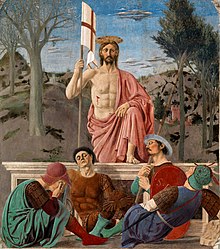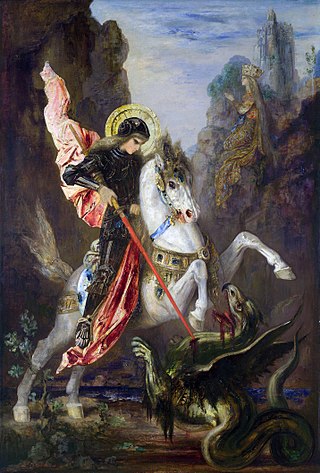
Christian mythology is the body of myths associated with Christianity. The term encompasses a broad variety of legends and narratives, especially those considered sacred narratives. Mythological themes and elements occur throughout Christian literature, including recurring myths such as ascending a mountain, the axis mundi, myths of combat, descent into the Underworld, accounts of a dying-and-rising god, a flood myth, stories about the founding of a tribe or city, and myths about great heroes of the past, paradises, and self-sacrifice.

Parashurama, also referred to as Rama Jamadagnya, Rama Bhargava and Virarama, is the sixth avatar among the Dashavatara of the preserver god Vishnu in Hinduism. He is believed to be one of the Chiranjivis (Immortals), who will appear at the end of the Kali Yuga to be the guru of Vishnu's tenth and last incarnation, Kalki.
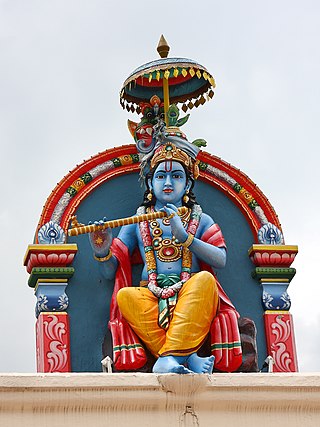
Krishna is a major deity in Hinduism. He is worshipped as the eighth avatar of Vishnu and also as the Supreme God in his own right. He is the god of protection, compassion, tenderness, and love; and is widely revered among Hindu divinities. Krishna's birthday is celebrated every year by Hindus on Krishna Janmashtami according to the lunisolar Hindu calendar, which falls in late August or early September of the Gregorian calendar.

Vritra is a danava in Hinduism. He serves as the personification of drought, and is an adversary of the king of the devas, Indra. As a danava, he belongs to the race of the asuras. Vritra is also known in the Vedas as Ahi. He appears as a human-like serpent blocking the course of the Rigvedic rivers, and is slain by Indra with his newly-forged vajra.

Theophany is an encounter with a deity that manifests in an observable and tangible form. It is often confused with other types of encounters with a deity, but these interactions are not considered theophanies unless the deity reveals itself in a visible form. Traditionally, the term "theophany" was used to refer to appearances of the gods in ancient Greek and Near Eastern religions. While the Iliad is the earliest source for descriptions of theophanies in classical antiquity, the first description appears in the Epic of Gilgamesh.

On the City of God Against the Pagans, often called The City of God, is a book of Christian philosophy written in Latin by Augustine of Hippo in the early 5th century AD. The book was in response to allegations that Christianity brought about the decline of Rome and is considered one of Augustine's most important works, standing alongside The Confessions, The Enchiridion, On Christian Doctrine, and On the Trinity. As a work of one of the most influential Church Fathers, The City of God is a cornerstone of Western thought, expounding on many questions of theology, such as the suffering of the righteous, the existence of evil, the conflict between free will and divine omniscience, and the doctrine of original sin.
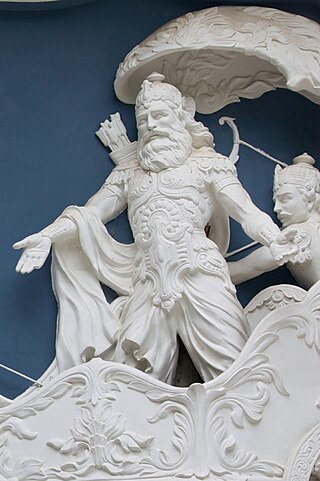
Bhishma, also known as Pitamaha, Gangaputra, and Devavrata, is a major character of the epic Mahabharata. He was the supreme commander of the Kaurava forces during the Kurukshetra War of the epic. He was the only character who witnessed the entirety of the events of the Mahabharata, beginning from the reign of his father, King Shantanu of the Kuru kingdom. Bhishma was the stepbrother of Vyasa, the grandfather of both the Pandavas and the Kauravas. He was a prominent statesman of the Kuru Kingdom. He was born as the youngest son of the illustrious King Shantanu and goddess Ganga.

Narayana is one of the forms and epithets of Vishnu. In this form, the deity is depicted in yogic slumber under the celestial waters, symbolising the masculine principle and associated with his role of creation. He is also known as Purushottama, and is considered the Supreme Being in Vaishnavism.

A battle cry or war cry is a yell or chant taken up in battle, usually by members of the same combatant group. Battle cries are not necessarily articulate, although they often aim to invoke patriotic or religious sentiment. Their purpose is a combination of arousing aggression and esprit de corps on one's own side and causing intimidation on the hostile side. Battle cries are a universal form of display behaviour aiming at competitive advantage, ideally by overstating one's own aggressive potential to a point where the enemy prefers to avoid confrontation altogether and opts to flee. In order to overstate one's potential for aggression, battle cries need to be as loud as possible, and have historically often been amplified by acoustic devices such as horns, drums, conches, carnyxes, bagpipes, bugles, etc..
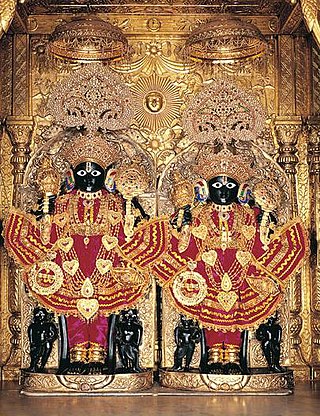
Naranarayana, also rendered Nara-Narayana, is a Hindu duo of sage-brothers. Generally regarded to be the partial-incarnation (aṃśa-avatara) of the preserver deity, Vishnu, on earth, Nara-Narayana are described to be the sons of Dharma and Ahimsa.
To surrender in spirituality and religion means that a believer completely gives up his own will and subjects his thoughts, ideas, and deeds to the will and teachings of a higher power. It may also be contrasted with submission. Surrender is willful acceptance and yielding to a dominating force and their will.

The Kurukshetra War, also called the Mahabharata War, is a war described in the Hindu epic poem Mahabharata , arising from a dynastic struggle between two groups of cousins, the Kauravas and the Pandavas, for the throne of Hastinapura. The war laid the foundation for the events of the Bhagavad Gita.

Unlimited atonement is a doctrine in Protestant Christianity that states Jesus died as a propitiation for the benefit of all humans without exception. It is normally associated with Amyraldism, as well as Arminianism and other non-Calvinist tradition. It is a doctrine distinct from other elements of the Calvinist acronym TULIP and is contrary to the Calvinist doctrine of limited atonement.
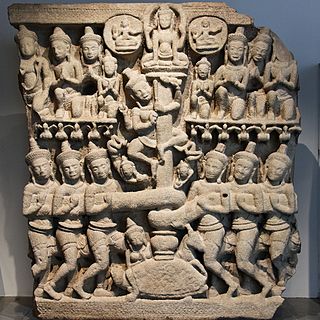
Hindu mythological wars are the wars described in the Hindu texts of ancient India. These wars depicted both mortals of great prowess as well as deities and supernatural beings, often wielding supernatural weapons of great power. Hindu teachings prescribe war as the final option, to be employed only after all peaceful methods are exhausted. Participation in righteous war, or dharmayuddha, was said to be honourable and was a principal duty of the Kshatriya or the warrior varna, and victory in such wars was regarded as a matter of honour.
In the Hindu epic Mahabharata, Krishna is the son of the Yaduvamsha chief Vasudeva and his wife Devaki. He is also widely known by his epithet, Vāsudeva.

The Dashavatara are the ten primary avatars of Vishnu, a principal Hindu god. Vishnu is said to descend in the form of an avatar to restore cosmic order. The word Dashavatara derives from daśa, meaning "ten", and avatāra, roughly equivalent to "incarnation".

The Bhishma Parva, or the Book of Bhishma, is the sixth of eighteen books of the Indian epic Mahabharata. It has 4 sub-books and 124 chapters.
The Drona Parva, or the Book of Drona, is the seventh of eighteen books of the Indian epic Mahabharata. Drona Parva traditionally has 8 parts and 204 chapters. The critical edition of Drona Parva has 8 parts and 173 chapters.
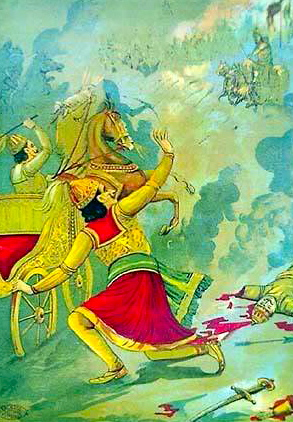
The Karna Parva, or the Book of Karna, is the eighth of eighteen books of the Indian Epic Mahabharata. Karna Parva traditionally has 96 chapters. The critical edition of Karna Parv has 69 chapters
The Mausala Parva is the sixteenth of the eighteen books of the ancient Indian epic Mahabharata. It traditionally has nine chapters. The critical edition has eight chapters. One of the 3 shortest books within the epic, the Mausala Parva describes the demise of Krishna in the 36th year after the Kurukshetra war had ended, the submersion of Dvaraka under sea, death of Balarama by drowning in the sea, Vasudeva's death, and a civil war fought among the Yadava clan that killed many of them. The story of infighting of the Yadavas becomes the reason why the Pandava brothers renounce their kingdom and begin their walk towards heaven, events recited in the last two books of the Mahabharata.
